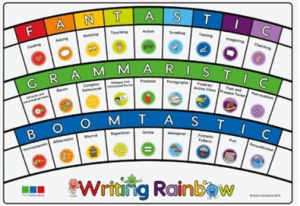Implementation
At St Clement’s we have adopted ‘The Write Stuff’ by Jane Constantine to bring clarity and consistency to the mechanics of writing and to enable our children to write effectively and coherently. As a school, all children from Year 1 to Year 6 learn to write through the Write Stuff approach. This was developed by teacher and leading English consultant, Jane Considine. It is a fun, creative and rigorous approach to develop children’s writing. This approach allows children to apply basic skills, vocabulary and grammar knowledge to write effective sentences, which are full of impact and keep the reader interested.
In The Write Stuff approach to writing, the children explore high level, rich vocabulary and are taught grammar in context through different writing lenses on the Writing Rainbow. There are three lenses used to support children with their writing:
Fantastics – ideas for writing
Grammaristics – tools for writing
Boomtastics – writing techniques

The Write Stuff is based on two guiding principles; teaching sequences that slide between experience days and sentence stacking lessons.
As part of the teaching sequence, teachers plan experience days; sentence stacking lessons and independent writing sequences. Experience days immerse children in experiences linked to their writing and drench them in vocabulary linked to the lenses in ‘The Writing Rainbow’. From the experience days, children take part in the sentence stacking lessons. Sentence stacking lessons focus on writing three sentences with focuses on lenses of the rainbow.
‘The Write Stuff’ follows a method called ‘Sentence Stacking’ which refers to the fact that sentences are stacked together and organised to engage children with short, intensive moments of learning that they can then immediately apply to their own writing.
An individual lesson is based on one plot point from the text, broken in to three learning chunks:
- 1. Initiate section – a stimulus to capture the children’s imagination and set up a sentence.
- 2. Model section – the teacher models a sentence that outlines clear writing features and techniques.
- 3. Enable section – the children write their sentence, following the teacher’s model.
This part of the unit is heavily scaffolded with lots of teacher input and modelling of vocabulary use, sentence construction and use of grammar with reference to the 3 writing lenses.
During the initiate section children ‘chot’ (chat and jot) down their ideas from stimulating resources, such as pictures, music and drama. The children are encouraged to use ‘kind calling out’ where they call out examples of vocabulary, adverbs, onomatopoeia etc.
During the Model section the teacher prepares children for writing by modelling the ideas, grammar and techniques of writing taken from the writing rainbow.
In the Enable section pupils write their own sentences, taking the opportunity to deepen the moment. ‘Deepen the Moment’ is where children are challenged to independently draw upon previously learnt skills and apply them to their writing during that chunk.
Following the sentence stacking, children are given the opportunity to show what they have learnt by planning and writing their own independent piece of writing. After they have written their independent piece, their work is marked by the class teacher who identifies different aspects of their written piece to be edited. There are 3 elements to the editing;
E1 Edit: The Revise
Edit Type 1: These are often ‘little’ adjustments or changes and tend to fall into one of these categories; Spellings Missing words or Punctuation
E2 Edit: The Rewrite
Edit Type 2: Children are asked to re-write a sentence if it doesn’t make sense, could be restructured or generally improved.
E3 Edit: The Reimagine
Edit Type 3: This is when a writer wants to add more sentences to develop an idea further. For this the children are shown how to use ‘editing flaps’.
Editing flaps are extra pieces of paper that stick onto their writing and show the additional sentences added into their work.
The Write Stuff provides a balance of narrative, non-fiction and poetry writing throughout each term.
Impact
Having followed the Write Stuff approach to developing their writing skills children should be able to
- write for a range of purposes including diary entries, persuasive letters, stories, poems and recounts to name but a few.
- use their vast knowledge of vocabulary to excite, inform or entertain the reader.
- understand a range of punctuation and the effect it can have on the reader in both writing and reading.
- understand and be able to use a range of grammatical devices.
- understand the various sentence types that can be used to support different genres.
- spell accurately using their phonetic knowledge and apply spelling rules.
- to speak clearly, fluently and coherently, to be able to listen attentively with understanding, pleasure and empathy and contribute to group discussions
English Unit Plans
Jane Considine’s English Unit Plans Year 1 Tracker
Jane Considine’s English Unit Plans Year 2 Tracker
Jane Considine’s English Unit Plans Year 3 Tracker
Jane Considine’s English Unit Plans Year 4 Tracker